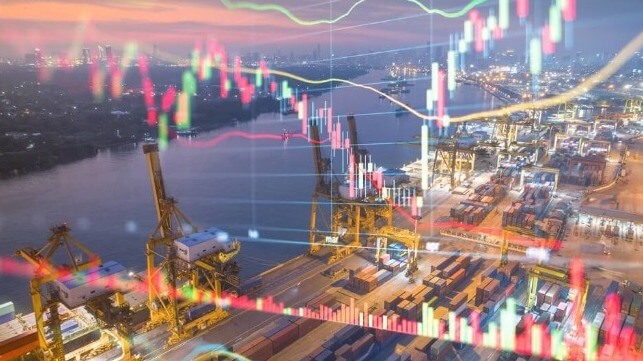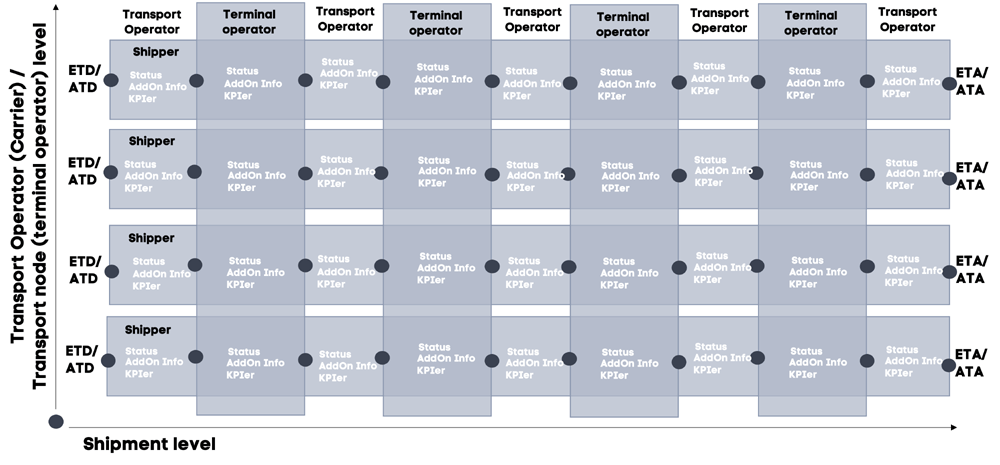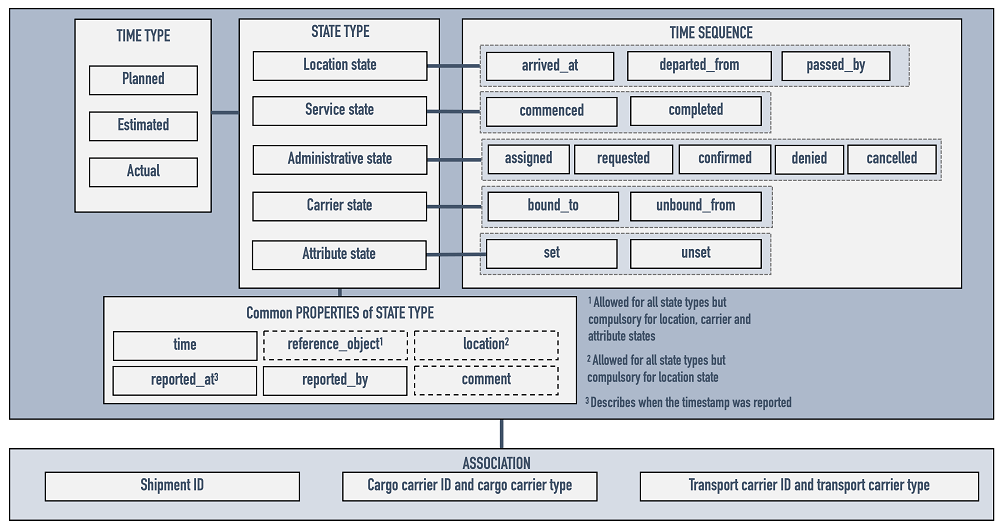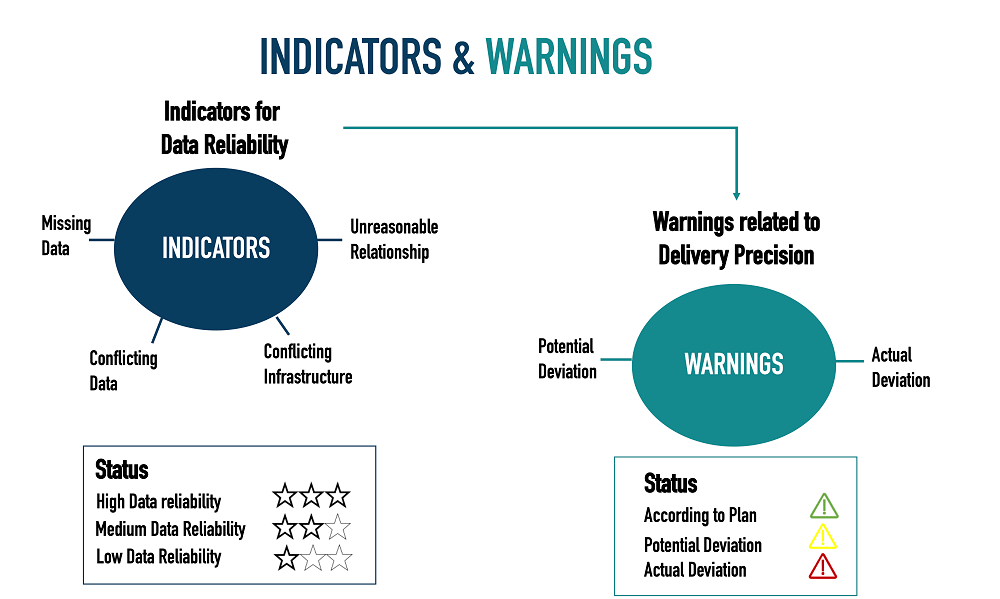VWT - A Novel Concept to Capture the Value of Supply Chain Data

[By Mikael Lind, Wolfgang Lehmacher, Sandra Haraldson, Pontus Drejer, Kenneth Lind, Abhinayan Basu Bal, Noah Cepela, Xiao Feng Yin and Trisha Rajput]
Discussions in the supply chain and logistics industry continuously point out that large-scale cross-industry data sharing would yield significant improvements in supply chain performance and sustainability. Recent major success of data sharing platforms around ocean transport (TradeLens) proved the validity of the assumptions: the technology worked, parties were willing to share, the supply chain performance was boosted. Still, this platform fell apart. So, what is it that hampers the sharing of data which is the currency of the digital economy? Some say it is policies and laws like the European Union General Data Protection Regulation (GDPR) and competition laws. Others mention the contractual architecture of the trade industry. Some believe it is the lack of standards and global alignment or of clarity of objectives and future use of the solutions, and again others say that the problem is that actors benefit from intransparency and information arbitrage. All these may be valid reasons. But reality has again and again proven that innovations get traction when incentives are right, i.e., when the value proposition exceeds the effort / risk or regulations come into force.
Usually, behavior change in the economy is triggered by monetary rewards, like cost advantages, subsidies, and new revenue opportunities, or new restrictions. The introduction of AIS is a good example. About 20 years ago, the maritime sector has undergone major change when sharing of position, speed and heading became legally mandatory as a safety requirement. This change resulted in higher safety standards but created also a new market for digital services leveraging AIS data. What is needed to repeat such a transformation? We believe that events and developments like Covid-19 and climate change have created new needs which will drive the maritime industry towards broader intra-chain and inter-chain data sharing. With buyers facing more frequent and severe supply chain disruptions that negatively impact their business and new environmental and climate protection regulation, the sharing of data, e.g., on greenhouse gas (GHG) emissions and on cargo movements in general has become much more important.
This article presents a novel approach to private data sharing applied by the virtual watch tower VWT (www.virtualwatchtower.org) which was launched as a complementary testbed and space for digital data sharing and collaboration during the Singapore Maritime Week 2023. The cargo owner-driven and terminal-centric VWT creates economic and societal value by solving real problems (incentives / key performance indicator KPI-triangle: efficiency, reliability, sustainability) for participants by building a community (partnering for co-creation), applying a distributed design approach (system-of-systems), offering AI-powered services (middleware), leveraging existing interoperability efforts (message formats and data standards), as well as proven templates (illustrative design instruments), legal instruments (power of attorney and partnership agreement), and effective rules and mechanisms (design principles and network governance) to protect and support the community and each individual member in the leanest possible way. This concept can also be described as the Internet of VWTs (IVWT).
Data sharing for economic and societal value creation
The virtual watch tower (VWT) is a cargo owner-driven and terminal-centric initiative to develop an impartial entity and solution co-created by a voluntary group of actors pursuing shared goals (KPI-triangle: efficiency, reliability, sustainability) across multi-modal supply chain networks connected through a middleware linking the VWTs of the different community members. The VWT enables structured data sharing for situational awareness, AI-powered data analysis, and digitally empowered collaboration. The VWT produces outcomes for specific use cases, such as GHG emissions calculations. It also offers popup situation rooms for collaboration in crisis situations. VWT-created common situational awareness is driving collaboration in areas of shared interest like managing disruptions. The VWT follows the CDES paradigm which stands for collaboration and digitalization working in symbiosis to generate both economic and societal capital.
Its terminal-centric viewpoint - which does not contradict that all parties involved in multi-modal end-to-end (e2e) logistics and transport chains should be treated equally - underlines that terminal operators that are located at different types of transport nodes hold a prominent position as enablers of common situational awareness and locus of corrective action. Transport nodes (ports, inland terminals, railway terminals, and airports) are intermediate points of destination that should serve as digital hubs supporting visibility. Vehicles, e.g., trains, ships, and airplanes operated by different carriers often co-utilize infrastructure, which complicates alignment between different cargo owners and other supply chain actors on actions during transport. At least, carriers should share the necessary minimal data set of cargo movements and operational data to immediate downstream actors to allow those to take precautionary measures at the next point of arrival and possibly at locations further downstream of the supply chain.
How value is created by the VWT
The ultimate customer in transport is the party that pays for the logistics and transport services. This can be senders or receivers of goods, or both. They have the legal / contractual power to instruct freight forwarders, logistics services providers, carriers, and other actors along the chain to share data related to their cargo and respective movements. They can also demand best efforts to solve problems. Within the VWT, the cargo owners transfer through a power of attorney (PoA) their legal rights to claim and obtain digital data from the parties involved in their transports to the VWT. The PoA empowers the VWT to share predefined data sets across predefined clusters of partners. Hence, it is the PoA that is the instrument and incentive that unlocks private data sharing in the VWT.
The cargo owners are motivated to issue a PoA by the perspective of obtaining higher levels of visibility for better situational awareness, decision-making, and problem-solving. As we observe emerging ceilings/limits in defining value and benefit of more granular visibility, often simply explained as “enables better exception management”, the VWT focusses in particular on ”so what” aspects. As an example, once the VWT predicts a delayed arrival of a container, the VWT seeks to understand what subsequent actions are to occur and how, who is better enabled and empowered to deal with that variance, and what methods of information sharing can facilitate this type of output. The VWT provides a platform for collaboration to turn insights into improved results (KPI-triangle).
One may think that the PoA should be enough reason for supply chain actors to engage. But there are additional incentives. These include higher retention through improved customer satisfaction as the result of better, faster, and less-costly responses to customer needs enabled by a new way of streamlining information. Transparency makes it easier to comply with increasing government demands. Transparency on an industry wide scale opens the possibility to negotiate regulatory burden reliefs with governments: fast lanes, quick releases in ports, less forms to fill, less question to answer. These will expedite transports and reduce cost.
Data to share, when and with whom
The concerns of cargo owners define their data needs. The cargo flow is the common object of interest of the involved parties in a cargo owner’s logistics and transport chain. In the transport process the cargo might be “assigned” to a transport carrier which allows to reduce the scope of monitoring to the vehicle on a voyage until it reaches the node where the cargo is discharged and “unassigned”. Corrective actions can be taken before the cargo is reloaded and “re-assigned” to the subsequent vehicle and carrier.
Data requirements change with the goals but also with the role of an actor in a chain. Cargo owners usually require more coarse-grained data along the entire multi-modal e2e chains while carrier and terminal operators require richer data sets that are often only shared if at all with succeeding downstream actors (Figure 1). According to the data sharing design principle adopted by the VWT logistics and transport services providers initially only share data with their two succeeding downstream actors in a cargo owner’s chain.

Figure 1: Differences in type of data needed for actors. Shippers depicted on the horizontal layer of the graph need coarse-grained (holistic) data of events along the end-to-end chain and carrier and terminal operators depicted at the vertical layer of the graph need fine-grained (detailed) data for the part of the transport chain they are involved in (Illustration: Sandra Haraldson).
The type of occurrences may narrow down the data required which can facilitate efforts, e.g., around confidentiality concerns and potential coding mechanisms to help sort / categorize events.
An illustrative conducive discussion, reflection, and design instrument in the effort of achieving visibility, situational awareness, and digitally empowered collaboration between actors in multi-organizational settings is the e2e metromap (Figure 2). This metromap, which captures the common object of interest and which shows all possible coordination points and their order of occurrence is used to identify specific key points of data collection and operational coordination to reach agreement on which data is needed to be shared between the participants in order to empower each party engaged along the chain to make the best possible decisions. The coordination points depicted in the e2e metromap are based on the specific events along the logistics and transport chain, at connected nodes and during the movement of cargo between nodes. There are other metromaps covering additional phenomena, such as operations associated to a transshipment hub.
Metromaps have successfully driven agreement on when (in which order), what, and with whom data should be shared in processes of collaborative decision making (CDM) for different settings, such as at seaports (PortCDM), for the railway sector at railway stations and railway yards (RailwayCDM), at inland terminals (RRTCDM), airports (A-CDM), and now within the scope of the VWT in e2eCDM. All of those settings are multi-organizational practices requiring the engagement of a multitude of organizations to deal with intra-chain and inter-chain dependencies. The e2e metromap that we are using in the VWT development is depicted in Figure 2. This metromap follows the design principles of the VWT and illustrates the need to share data on planned / estimated / actual events associated to the departure and arrival of vehicles (transport) and commenced and completed handling in e2e logistics and transport chain networks.

Figure 2: The metromap for end-to-end CDM underlying the VWT network approach (Illustration: Sandra Haraldson)
In the VWT setting, the data sovereignty of each partner is protected through the pre-agreed purpose and scope of use of the data shared with the VWT. If required, for example when disruptions occur, actors can agree to share additional data. All data shared gets pushed to the buyer of the specific logistics and transport services.
The data sharing within the VWT establishes a certain level of visibility to feed analytical services to for example calculate estimated times of arrival (ETA) or the calculation of GHG emissions of specific or alternative operations. Data sharing improves operational efficiency by e.g., responding to disruptions more effectively and timely. It also facilitates just-in-time arrival for ports and services such as bunkering and cargo handling by optimizing ETA accuracy and readiness for services, contributing to fuel savings by supporting slow steaming and reductions of turnaround times at ports. A minimalistic set of data (defined and agreed upon with the help of the metromap (Figure 2)) is shared between different VWTs to increase visibility and generate additional chain insights produced by services / modules operated in different VWTs improving outputs for better individual and collaborative decision-making.
Using a common language and tested off-the-shelf frameworks simplifies data sharing. The VWT leverages existing efforts using Transport Collaboration Message Format (TCMF) (Figure 3) and other standards, e.g., those created by the Digital Container Shipping Association (DCSA) and the United Nations Centre for Trade Facilitation and Electronic Business (UN/CEFACT). TCMF defines the smallest building block in VWT data sharing. Members need to conform to the system required minimums, i.e., predefined elements of data and standard required.
Derived from the e2e metromap (Figure 2), figure 3 below depicts the elements to be shared among parties involved in in specific transports, i.e., timestamps on plans and progress of expected / executed logistics operations (movements and other transport services) and administrative elements.

Figure 3: Transport Collaboration Message Format (TCMF)
This TCMF message format captures movements and handling situations in supply chains that may jeopardize specifically delivery commitments. Other goals like GHG emissions and costs reductions targets require complementary solutions, of which many have already been developed elsewhere and are ready for use by the VWT.
Capturing value through e2eCDM indicators and warnings
The data channeled through the network of connected VWTs, which can be perceived as the Internet of VWTs (IVWT) allows for generating data indicators and operational warnings. Both types help to raise situational awareness in e2e supply chain networks. As data feeds key performance indicators (KPIs) and indicators and warnings help to meet set financial, service level, and sustainability goals, the IVWT helps supply chain actors to protect value and capital, e.g., through precautionary measures in case of potential disruptions.
Data quality is one of the biggest issues in the industry. The metromap (Figure 2) informs about relationships between different events of which data is shared in the form of timestamps, which also forms the foundation for identifying data quality issues, e.g., that an arrival occurs prior to a departure or that it is not reasonable that a movement is possible to make due to the current position and the distance needed to travel to reach the planned time at the targeted physical location indicating that there may be an issue with the data (unreasonable relationships).
There are regular conflicts between data from different data sources (conflicting data), reflecting the different conceptions of reality among supply chain participants. The shared data also provide indications for the utilization of infrastructure, such as a berth. As timestamps are associated with temporal-spatial (time and location) dimensions we can identify when timestamps of specific events were not shared across the network (missing data) or whether the same berth would be occupied by ships at the same time (conflicting infrastructure).
Figure 4 depicts the four types of data quality indicators elaborated on above and two types of operational warnings. Bad data leads to bad decisions. Indicators help to instill confidence in data so that actors can trust in the accuracy of warnings. Incongruencies in data sets help to identify data input, gathering or generation errors. Generating valuable sustainability and efficiency data insights necessitates and relies on accurate, timely data related to the movement of cargo and underlying operations.

Figure 4: Indicators and warnings within e2eCDM as a foundation for the alert function of VWT (Illustration: Sandra Haraldson)
The network of VWTs and the larger pool of timestamps aggregated by the different VWTs of the VWT members increase chances to improve data quality. Data quality is a prerequisite for issuing accurate and meaningful warnings associated to the triangle of KPIs (efficiency, reliability, sustainability) addressed by the VWT. Data quality has two dimensions: internal, i.e., the human ability to ensure information is updated and not kept in bubbles, and external, i.e., data coming from third party actors. Internet of things (IoT) devices contribute to improving data quality but to achieve real impact the current rate of adoption needs to be significantly accelerated.
VWT design principles
Continuously, data sharing raises concerns. A successful soultion requires that these concerns are transparently addressed. Clear design and governance principles are needed to establish trust. Trustworthy sponsors facilitate the effort. The VWT applies the following design principles:
- the IVWT (Internet of VWTs) is distributed and impartial
- VWT acts as a facilitator for lean data sharing and in prinicple data is used and not stored, adopting a federated model where data remains under ownership of the originator
- the data sought serves to reach the common goals, i.e., make the KPI-triangle work
- the one who owns data defines what and with whom this data can be shared across the VWT network
- only specific minimalistic data sets are shared across pre-defined partners of the VWT network
- the VWT network and its community members comply with cybersecurity standards
- the VWT network is a steppingstone to an ever-growing ecosystem gradually increasing the value for each partner in the network
- the VWT has a financial charter, which states how costs are covered, and investments and potential incomes are shared across the IVWT
The design principles are geared towards direct usefulness, i.e., the KPI-triangle (efficiency, reliability, sustainability) and are embedded in an effective and lean VWT governance framework which determines the scope and rules of engagement of the connected VWTs and establishes transparency on how decisions are being made. In a world where the weakest link determines the common performance, the KPI-triangle reflects “collaborative decision making”. The intent is to establish governance rules that are clear about ‘systems intentionality’ and the value created for the VWT community and each member manifesting the VWT’s overarching and high-level purpose, beliefs and values which eventually further the sense of community and act as a ‘community binder’ grounded in a clear and easy to understand value proposition providing significant incentives to those that comply with the common code.
Conclusions and call to join the movement
This innovative VWT initiative which also can be perceived as the Internet of VWTs (IVWT) is driven by a community which is open to try new ways of operating to overcome significant but surmountable challenges in global supply chain networks. This VWT community is open for actors to join so that everyone can benefit from the value created. We believe that the clear value proposition of the impartial shipper-driven and terminal-centric system-of-systems solution puts data sharing and collaboration in supply chains, trade, and logistics on a new track towards higher levels of efficiency, reliability, and sustainability.
It should be in everyone’s interest to join the VWT initiative to enhance economic and societal value individually, collectively, and globally. This is what keeps the initiating community of the VWT motivated. The more organizations join the initiative the higher the value for each individual community member, the industry, and the supply chain ecosystem. We call for collaboration and intra-chain and inter-chain private data sharing; public data sharing will be covered in an additional article. More importantly, we invite all members of the global supply chain ecosystem to join this effort to create an impartial, self-sustaining entity, that acts as a catalyst, enabling more efficient, reliable, and sustainable supply chain networks which this article has further concretized.
Acknowledgement
We acknowledge and appreciate inputs received from Henk Mulder (IATA), Michel Sancricca (Secro® Inc), Margi van Gogh (World Economic Forum), Norbert Kouwenhoven (Business and IT consultant) and André Simha (Mediterranean Shipping Company).
About the authors
Mikael Lind is world’s first (adjunct) Professor of Maritime Informatics engaged at Chalmers, and Research Institutes of Sweden (RISE). He is an expert contributor at World Economic Forum, Europe’s Digital Transport Logistic Forum (DTLF), and UN/CEFACT. He is co-editor of the first two books on maritime informatics, and is co-author of Practical Playbook for Maritime Decarbonisation.
Wolfgang Lehmacher is partner at Anchor Group and advisor at Topan AG. The former director at the World Economic Forum, and CEO Emeritus of GeoPost Intercontinental, is Advisory Board Member of The Logistics and Supply Chain Management Society, Ambassador F&L, Advisor GlobalSF, Advisor RISE, and member of the think tanks Logistikweisen and NEXST.
Sandra Haraldson is Senior Researcher at Research Institutes of Sweden (RISE) and has driven several initiatives on digital collaboration, multi-business innovation, and sustainable transport hubs, such asthe concept of Collaborative Decision Making (e.g. PortCDM, RailwayCDM, RRTCDM) enabling parties in transport ecosystems to become coordinated and synchronised by digital data sharing.
Pontus Drejer is a research engineer at Research Institutes of Sweden (RISE) who has worked hands-on with building demonstrators for CDM projects since 2017. He holds a BSc in computer science from the University of Gothenburg and has several years of both industry and research experience building software.
Kenneth Lind is Senior Researcher at Research Institutes of Sweden (RISE) and has driven several research projects focusing on system architecture and software engineering challenges in the automotive and transport sector. He holds a PhD in software engineering from Chalmers University of Technology and has 20 years of industrial experience as technical leader.
Abhinayan Basu Bal is a Senior Lecturer at the School of Business, Economics and Law in Gothenburg, Sweden. He lectures and researches in commercial and maritime laws with emphasis on digitalisation and sustainability. Since 2013, he is the accredited Swedish observer to UNCITRAL Working Group IV on Electronic Commerce.
Noah Cepela is a global supply-chain digital transformation leader and analytics expert who brings extensive experience to the role of President at BridgeNet Solutions. Noah joined the organization in 2007, and coordinated the latest release of the XONAR platform, which supports the 4PL product.
Xiao Feng Yin is a senior research scientist of Institute of High Performance Computing, Agency for Science, Technology and Research (A*STAR) of Singapore. He has led various grants and industry projects in the areas of maritime study, logistics and supply chain. He received both his Master and PhD degrees from Nanyang Technological University (NTU), Singapore.
Trisha Rajput is a Researcher at the School of Business, Economics and Law at University of Gothenburg. Her current research focuses on platforms that facilitate trade; and enhance the visibility, efficiency and predictability of global value chains. Her work on single window interoperability has been presented at UNCITRAL in Vienna.
The opinions expressed herein are the author's and not necessarily those of The Maritime Executive.
